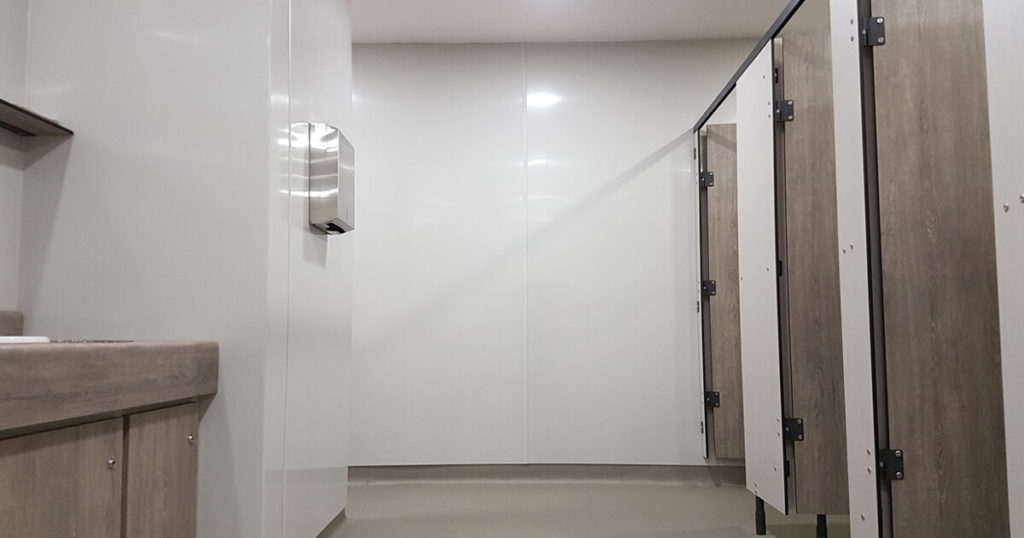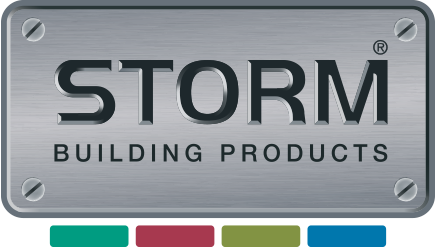
What is hygienic PVC cladding?
Cladding is a type of material that’s attached to the primary structure of a building, almost acting as its ‘skin’. There is no particular material that is always used, instead, cladding is an umbrella term for all materials that can be used for this purpose.
Hygiene cladding specifically is designed and manufactured for use in clean environments, with unique features such as chemical resistance and easy wipe cleaning.
In this article, we’ve covered everything you need to know about hygiene cladding including:
- The benefits
- What STORMclad is
- Where hygiene cladding should be used
- If hygiene cladding is expensive
- Frequently asked questions
- How hygiene cladding is installed
What are the benefits of hygiene PVC cladding?
Installing tiles takes a lot of preparation, which can be a significant cost on top of the installation and purchase costs.
Hygiene cladding takes less preparation, with tiles not only do you have to lay individual squares but you must also ensure accurate alignment and adequate grouting.
Also, PVC hygienic cladding sheets are much larger than tiles making them a cost-effective alternative to traditional tiling as installation is straightforward and cost-effective.
Hygienic wall cladding is designed to be easy to clean, which is why it’s so useful for areas where hygiene is important, such as a kitchen, laboratory, or lavatory.
For example in a kitchen, ingredients can easily splash onto the wall; with hygienic wall cladding, it can be easily and quickly cleaned, potentially benefiting the kitchen’s hygiene rating.
Hygiene wall cladding is also durable, impact resistant and long-lasting, which is especially useful for gyms and sports halls where these features are crucial.
It’s even resistant to chemicals, which is vital for hospitals and laboratories.
PVC wall cladding is also able to withstand heat, cold, and damp, which makes it almost completely maintenance free.
What is STORMclad hygiene PVC cladding?
STORMclad is a flat, solid PVC sheet specifically designed and manufactured for use in hygiene environments and offers excellent resistance to chemicals.
It can also be easily transformed, fabricated and used for digital or traditional printing.
STORMclad is perfect for use in food and hygiene areas, clinics, hospitals, schools, laboratories and commercial kitchens.
STORMclad is food and hygiene approved and has a class 1/0 fire rating, it’s competitively priced, readily available, and comes with a range of trims and adhesives.
Where should hygiene PVC cladding be used?
Hygiene cladding should be used wherever hygiene is important, such as:
- Kitchens
- Laboratories
- Bathrooms/Toilets
- Clinics
- Hospitals
- Schools
- Sports Halls
- Gyms
Is hygienic PVC cladding expensive?
Hygienic cladding is a cost-effective alternative to tiles, providing the same look at a much lower cost and with additional benefits.
Tiles are fragile and can break easily, which can be costly to replace and will take time to refit.
Compared to other forms of cladding such as wood, brick or stone, PVC cladding is extremely economical due to its durability. In the unlikely event that it is damaged, it’s simple to repair and replace.
PVC cladding can even be made to mimic the aesthetic of wood and stone.
Can PVC cladding be painted?
Yes, PVC cladding can be painted. Just make sure that it has been properly prepared and primed. Make sure the surface is clean, dry and free from anything that will interfere with the paint. Be sure to use a primer before painting.
Can PVC cladding go over tiles?
Yes, you can apply cladding directly on top of existing tiles as long as the tiles are in good condition (i.e. no loose or missing tiles). The tiles need to be covering the entire wall from top to bottom. If the tiles are only in the middle of the wall you won’t have a flat surface to work with.
Can PVC cladding catch fire?
PVC is an inherently fire resistant plastic and STORMclad PVC Sheeting can attain CLASS 0 fire rating when adhered to a non-combustible surface. A class 0 rating protects your surface from the spread of flames and limits the amount of heat released from the surface during a fire.
How is PVC cladding installed?
- Ensure that the surface is dry and as flat as possible, as well as free from dust.
- Fix the first internal corner trim at the very end of the first wall you wish to start the installation with. This is so that you can slide the first panel into the trim.
- Measure the length required for the first panel and cut (if required) then slot the panel into the trim.
- Secure the protruding lip of the first panel to the wall and then slide the next panel into place. STORMclad panels will fit together with a tongue-and-groove joint to ensure quick and easy installation. This will also hide the fixings on the first panel.
- Continue until the end of the wall and cut the width of the last panel to suit the remaining wall space and allowing for the corner trim.
- Fix the corner trim to the wall and continue to fix the panels across the next wall.
- External corners can be used for windows and you may have to cut out a section of one of the panels for a switch.
Hygienic wall cladding near me
If you’re looking for a local supplier of hygienic wall cladding you can simply use our handy online tool to ‘Find your local distributor’ and we will be in touch to let you know where your local distributor of STORMclad hygiene cladding is.
Become a stockist
To become a distributor of hygiene wall cladding, all you need to do is fill out our ‘become a distributor’ form!
STORM Building Supplies offers one of the most comprehensive ranges of superior quality building products in the UK. STORM also provides distributors with relevant POS, marketing tools and marketing support to help you gain the sales you need!
You can also get in touch by emailing [email protected], calling 01278 455326 or filling in our online enquiry form.
This article was written by Jade Mitchell.
Jade is the Marketing Coordinator at STORM Building Products, she has been working in the building plastics industry since 2016 and has completed ISMM level 2 and 3.




